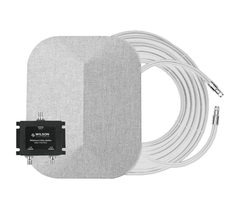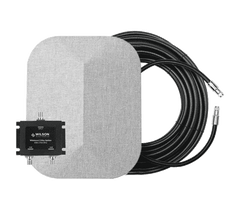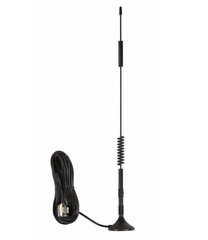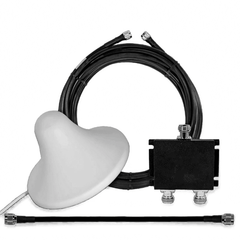Coax. Cable with SMA-RP Male to N-Male Connector (50 Ohm)
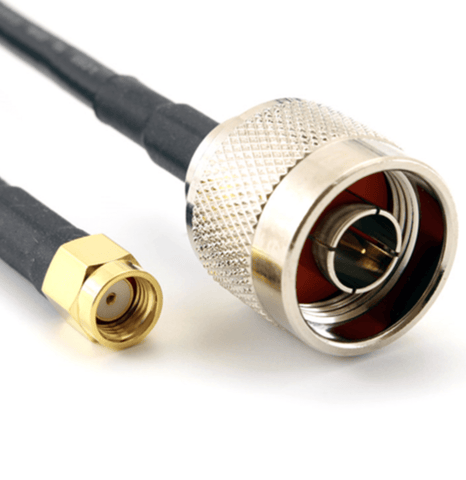
Coax. Cable with SMA-RP Male to N-Male Connector (50 Ohm)
Buy Now, Pay Later with No Interest if paid in full within 6-12 months. Choose Klarna payment option at the checkout for details of this, and other long-term low-interest financing options.
Free Lifetime Support. SKU / Model: NMALE-RPSMA-LMR195-3FT
Optional part popular with this cable: SMA-Female to TS9 Male Connector.
1(855)846-2654
Need installation quote, or help with designing a custom solution? Submit a request for quote.
- Description
- Reviews
- Questions & Answers
- Make An Offer
- Warning
Description
Product Description
Coax. Cable with RP-SMA Male to N-Male Connector (50 Ohm) is available in lengths of 3 ft. to 100 ft. These Low-Loss Coaxial Extension Cables (50 Ohm) have SMA-RP Male connector on one end and a N-Male connector on other end.
50 Ohm Coaxial Cable with SMARP Male and type N-Male Connectors are used for LTE, 4G, 3G, ADS-B, GPS, HAM and RF Radio applications when connecting to a surge arrester or antenna. Coax. This cable with RPSMA Male & N-Male Connector serves as an excellent jumper cable for many applications that include:
- Antennas for 3G, 4G, and LTE.
- Amplifiers, Routers, and Cellular Modems.
- ADS-B Receivers.
- Lightning Arresters or Surge Protectors
- Ham Radio Equipment.
Note that this cable is not used for HDTV.
General Product Information:
- Jumper Cable – N-Male to SMA-RP Male.
- This is an ultra-low loss coaxial cable.
- It is used to connect RP-SMA equipment to N-Style antennas.
- Signal pins allow for heat shrinking on both ends.
- This coaxial cable is compatible with SMA-based equipment, including routers and modems from Cradlepoint, Cisco, Sierra Wireless, Pepwave, Digi, Proxicast, MoFi, and many more.
- This 50 Ohm Coaxial Cable with RP-SMA Male and N-Male Connectors is an ultra-low loss jumper cable for amplifiers, routers, modems, and other radio devices.
- Use this cable on radio devices for connecting N-Female antennas to an external RP-SMA Female antenna jack.
- Devices that are compatible include GPS receivers, 4G LTE modems, boosters, hotspots, routers, ADS-B receivers, and HAM radios.
- Brands that are compatible include Cradlepoint, Cisco, FlightAware, Digi, Proxicast, Pepwave, MoFi, Sierra Wireless and others.
- Also use this cable to connect to an in-line surge protector or lightning arrestor.
Special Features of 50 Ohm Coaxial Cable with SMA-RP Male and N-Male Connector:
Low Signal Loss.
For maximum transmission and reception on common wireless frequencies, our ultra low loss 50 Ohm coaxial cable is the one to use. This cable is a dramatic improvement on "RG" coaxial cables.
Professional Grade Quality.
The use of high-quality commercial-grade components ensures durability and maximum toughness. Assembled cable is thoroughly inspected and tested by our experienced technicians.
Indoor and Outdoor Use.
The polyethylene jacket of this coaxial cable makes it moisture resistant and capable of withstanding outdoor use. However, please note that this cable is not rated for plenum or direct burial applications.
Other Significant Features:
- This cable is ideal for use in portable, temporary, stationary, and mobile vehicle applications.
- Both connectors have heat shrink tubing.
- This is a high-performance extension cable for GPS applications, and 3G, 4G, 5G, and LTE cellular broadband applications.
- Achieve maximum RF transmission and reception using this high-quality ultra-low loss 50 Ohms coaxial cable.
- Designed to connect equipment that require RP-SMA connections like boosters, routers, and modems, to N-connector-based antennas.
- This coaxial cable is rated for all conditions and climates and is capable of withstanding the demands of outdoor use. Note that this cable is not rated for direct burial or plenum applications.
- High-quality, commercial-grade components ensure durability and maximum toughness.
- Note that this 50 Ohm Coaxial Cable is not suitable for use with video devices (TV, satellite, cable).
Specifications of select lengths for Cable Assembly (RP-SMA Male to N-Male):
- 50 Ohm impedance.
- Connector No. 1: Gold plated Inline plug - SMA-Male.
- Connector No. 2: Nickel plated In-line plug – N-Male.
- 10-foot coaxial cable: LMR195 (Size RG58) – 3/16-inch diameter.
- 25-foot coaxial cable: LMR240 (Size RG8X) – 1/4-inch diameter.
- 50-foot coaxial cable: LMR400 (Size RG8) – 7/16-inch diameter.
This 50 Ohm Coaxial Cable is used to extend the location of 5G, 4G, LTE, and 3G cellular devices, like the following:
| Cellular Phones | 5G Phones | 4G Phones | LTE Phones | 3G Phones |
| Signal Amplifiers | 5G Amplifiers | 4G Amplifiers | LTE Amplifiers | 3G Amplifiers |
| Cellular Routers | 5G Routers | 4G Routers | LTE Routers | 3G Routers |
| Cellular Modems | 5G Modems | 4G Modems | LTE Modems | 3G Modems |
| Cellular Antennas | 5G Antennas | 4G Antennas | LTE Antennas | 3G Antennas |
Assembly Loss.
One key specification for all types of coaxial cable is loss, or attenuation. While the purpose of using coaxial cable is to transmit radio frequency power from point A to point B, there will always be power loss both along the RF cable length and also through the connectors due to cable imperfections, resistance, noise, and a variety of other factors. At any given frequency, this power loss, or attenuation, caused by the coaxial cable is defined in terms of Decibels (dB) per foot.
The five main elements that cause cable signal loss include:
- The frequency of signals transmitted.
- The quality of the assembly components.
- The length of the cable.
- The number of connectors.
- The diameter, or shielding, of the cable.
For distances of 10 feet or less, there's negligible signal attenuation at 5G, LTE, 4G, and 3G frequencies for most applications, so it is quite appropriate to use LMR-195 or LMR-100 sized coaxial cable. However, thicker coaxial cables are required for longer distances in order to minimize signal loss.
Shorter cabling should not be joined together to make a longer cable if you're trying to prevent excessive signal loss. Wherever possible, a single cable should be used. You can also use thick cable for the longer section of a cable run with a short, thin cable for connecting to antennas or equipment. The idea is to minimize the number of connectors and the total length of cable.
SignalBooster.com Coaxial Extension Cable Assemblies.
Coaxial extension cable assemblies by SignalBooster.com are top-quality, with well-constructed low-loss cable and gold-plated connectors. Each cable assembly is thoroughly tested at the time of manufacture.
Recommendations by SignalBooster.com:
- LMR400 coaxial assemblies for lengths up to 50 ft.
- LMR240 for lengths up to 25 ft.
- LMR195 coax for assemblies up to 10 ft.
If you require a custom cable assembly, simply contact SignalBooster.com with your requirements.
Total Assembly Signal Loss (Including Connectors):
| Signal Loss in: | 10 Ft. | 25 Ft. | 50 Ft. |
| Frequency | LMR195 | LMR240 | LMR400 |
| 5800 MHz | 3.4 dB | 5.7 dB | 6.1 dB |
| 5000 MHz | 3.2 dB | 5.3 dB | 5.6 dB |
| 2700 MHz | 2.3 dB | 3.8 dB | 4.0 dB |
| 2400 MHz | 2.1 dB | 3.6 dB | 3.7 dB |
| 1900 MHz | 1.9 dB | 3.2 dB | 3.3 dB |
| 1700 MHz | 1.8 dB | 3.0 dB | 3.1 dB |
| 900 MHz | 1.3 dB | 2.1 dB | 2.2 dB |
| 700 MHz | 1.1 dB | 1.9 dB | 1.9 dB |
RF Connectors.
The most popular RF connector used for 5G, LTE, 4G and 3G signal amplifiers, cellular modems and routers is the SMA Female Jack. There may be other devices that use N, SMB, FME, or other connectors, so check this by confirming with your equipment manufacturer.
You will find that most outdoor antennas have either N-Female or N Male connectors, while most indoor cellular antennas use SMA Male plug connectors.
With Wi-Fi equipment, reverse polarity RP-SMA connectors are typically used, and this includes devices that combine cellular and Wi-Fi radios. This is because RP-SMA and SMA connectors are not compatible and will not mate.
"F" connectors are often used for video equipment, and this includes closed-circuit TV, satellite TV, cable TV, and so on. In appearance and size they are very similar to SMA connectors, but they won't mate with SMA connectors. Keep in mind also that 75 Ohm coaxial cable is required for most video systems; not the 50 Ohm cable that is used for RF.
Please be sure to note the male-to-female mating of these connectors:
- SMA-Male mates with SMA Female connector.
- SMA Male DOES NOT mate with F-Female (Cable TV) connectors.
- SMA Male DOES NOT mate with RP-SMA (Wi-Fi) connectors.
- N-MALE mates with F-Female (Inline and Bulkhead) connectors.
- N-Male DOES NOT mate with SO-239, Mini-UHF, BNC connectors.
Important Note: In order to minimize moisture damage in cabling and connectors, ensure that all outdoor coaxial connections are weather-proofed. Our self-bonding silicon tape is ideal for quick and easy sealing of connections.
Compatibility of SignalBooster.com Coaxial Extension Cables:
- Compatible with Pocket PORT LTE, 3G, and 4G cellular routers and Proxicast LAN-Cell.
- Signal boosters from SureCall, Cellphone-Mate, Wilson, weBoost, zBoost, HiBoost, and others.
- Cellular equipment including LTE, 3G, 4G, 5G routers and modems from:
- Asus and Airlink.
- Cisco, Cradlepoint, CalAmp.
- Digi.
- Huawei.
- Multi-Tech, MoFi.
- Novatel, NetCom, Netgear.
- Option.
- Pantech.
- Proxicast, Pepwave.
- Sixnet/Red Lion, Sierra Wireless.
- Teltonika.
- Verizon Wireless, and many more.
Use SignalBooster.com parts and cables for IoT (Internet of Things), commercial and industrial applications like:
- Alarm Systems.
- Automated Teller Machines (ATMs).
- Aviation.
- Digital Signage.
- EMS.
- Fire Dept.
- Gaming Machines.
- Homeland Security, & Disaster Response.
- IMS.
- Internet Anywhere.
- Kiosks.
- Machine-To-Machine (M2M).
- Marine.
- Medical.
- Mobile & Stationary Hotspots.
- PLCs.
- Point-of-Sale (POS).
- Police Dept.
- Remote Control.
- Remote Data Collection.
- Remote Monitoring & Diagnostics.
- RTUs.
- SCADA.
- Telemetry.
- Temporary Locations.
- Traffic Control.
- Vehicles.
- Vending Machines.
- Video Surveillance Systems (Cameras, DVRs, NVRs, etc).
- and so much more.
Installation Tips.
- In order to minimize signal loss you should use the shortest possible length of coaxial cable.
- To avoid damaging the cable, you must be aware of the minimum bend radius.
- This cable should never be spliced or cut.
- Minimize the total length of cable run and minimum number of connectors.
- Ensure that all coaxial connections are fully tightened.
Part numbers / SKUs available:
Look in drop-down menu at the top for the following self-explanatory SKU / part #'s that are available:
- NMALE-RPSMA-LMR195-3FT.
- NMALE-RPSMA-LMR195-10FT.
- NMALE-RPSMA-LMR240-15FT.
- NMALE-RPSMA-LMR240-25FT.
- NMALE-RPSMA-LMR400-30FT.
- NMALE-RPSMA-LMR400-36FT.
- NMALE-RPSMA-LMR400-50FT.
- NMALE-RPSMA-LMR400-75FT.
- NMALE-RPSMA-LMR400-100FT.
Frequently Asked Questions and Answers:
Q: If I use a 25-foot cable to connect my antenna to a cellular modem, how much signal would be lost?
A: Depending on your cellular operator and the frequency used, you would lose between 1.9 and 3.7 dB. To clarify, at 700 MHz you would lose about 1.9 dB, and at 2600 MHz you would lose about 3.7 dB. For more details be sure to check this listing for the Loss Comparison Chart.
Q: Can you tell me if an AT-T 4G modem with two antenna ports will work, and will a splitter be needed to connect to both?
A: It will depend on the type of modem you have. Does your modem have RP-SMA female ports that extend out from the chassis? If they do, then this coaxial cable is the right one to use for connecting an external antenna with an N-Female connector. With a single antenna, a splitter cannot be used to service both antenna ports on your modem. LTE modems have been designed for optimal performance and, as such, have two attached independent yet identical antennas.
Q: Can I cut a 25-foot cable and put connectors on in order to pass through the wall of my RV so I can hook and unhook for travel use?
A: It is not recommended that this cable be cut; unless of course you have the correct coaxial connectors, and the right stripping, crimping and heat-sealing tools. This coaxial cable cannot be simply spliced, similar to the way you might splice a telephone cable. Our recommendation for what you're trying to achieve is that you use a "pass-through bulk-head" connector and mount it through the wall of your RV. A second coaxial cable can then be purchased for the other side of your connection. We also suggest that you consider a bulkhead lightning arrester to provide lightning protection for your antenna.
Q: The coaxial cable I have got is HughesNet cable. Can the cable supplied be shortened and the FME-male end be replaced with a regular F style connector?
A: We're assuming you're referring to the coaxial cable that is typically used with HughesNet, and that is the RG6/U coaxial cable. If that is correct, then the answer is no. That particular cable can't be replaced with this one because the RG6/U is a 75 Ohm cable which has been specifically designed for CATV applications. Ours has been designed for RF applications and is a 50 Ohm cable. A 50 Ohm cable should not be used to connect 75 Ohm equipment.
Q: Can you suggest an amplifier to connect this cable with the MoFi unit? I'm asking because I'm experiencing a lot of signal loss with this.
A: It is our recommendation that you purchase the WilsonPro (Model 460119) Signal 4G Direct Connect Amplifier, which should resolve this problem.
Q: Can you give me the diameter of the cable?
A: The diameter of the cable is 6.1 mm, or 0.24 inches.
Q: Please advise how much bend radius this cable can accept.
A: The minimum bend radius of the 240-size coaxial cable is 19mm, or 0.75 inches.
Q: Does this cable work well for all AIS receivers?
A: It depends – your receiver must have an RP-SMA connector for external antennas. There are other types of AIS receivers that have different types of antenna connectors.
Q: With a MIMO WiFi+LTE router, can this coaxial cable be run from the antennas to a splitter, then the recommended RP-SMA or SMA to the router?
A: In order to function efficiently, both Wi-Fi and LTE MIMO devices need two separate but identical antennas. Each antenna provides independent signals which are used to cancel out noise and establish a number of parallel connection channels. If you only use one antenna and a splitter, then you're reducing performance and defeating the advantages of MIMO.
Q: Is this cable recommended for connecting to a weBoost cell phone signal booster?
A: The answer depends on the weBoost model you have. This is the right cable if your model has an RP-SMA connector to the external antenna and uses 50 Ohm antennas.
Q: What type of cable is this 15 ft. and 25 ft. LMR240?
A: This coaxial cable is Commate CFD-240, which meets or exceeds cable specifications for LMR-240.
Q: Why is this cable used for Wi-Fi when it states, "Not for Wi-Fi"? When connected to a broadband router, will this cable work efficiently to boost cellular signal?
A: Most Wi-Fi devices have Reverse Polarity SMA connectors. This cable comes with same RP-SMA connectors that are used for wifi devices. You can use this cable to extend a connection between a radio and antenna, or a cellular router and an outside antenna, as long as the device has RP-SMA female connection. Just be sure that all external coaxial connections (between the antenna and the cable) have been weather sealed.
Reviews
Questions & Answers
QUESTIONS & ANSWERS
Have a Question?
Be the first to ask a question about this.
Data Sheet / User Guide
Make An Offer
Warning
Note: For any signal booster to help, outside signal strength must be at least -110 dB or there must be a clear line of sight to a cell tower that is within twenty miles. Before ordering, please check outside signal level in decibels or ensure that you can make and hold a phone call at any good spot outside where you can mount an exterior antenna. Square footage stated in signal booster listings is based on good signal outside. If it is any weaker, the boosted sq. ft. area will be considerably lower, accordingly.
Kevin K. of Anderson, California gave the following review:
Website is easy to use with plain straight forward info but could have had more on testing signal strength to make sure you get a strong enough booster.
Therefore, please note that stated sq. ft. coverage is based on good signal outside. For best results: If outside signal is weak, we suggest choosing the next higher sq. ft. coverage kit. If outside signal is very weak, we suggest choosing the kit with even more higher sq. ft. range bracket. Basically, higher the sq. ft. bracket, the more powerful the signal amplifier with greater Gain as well as higher uplink and downlink output power.
If outside signal is too weak (weaker than -110 dB), submit request for cell coverage solution assessment. Upon receipt of questionnaire, we will perform residential or business site survey. This will help us determine the system that is needed to improve cell coverage. Then, we will create system design using that system such as femtocell, active or hybrid distributed antenna system (DAS), or other carrier feed signal enhancing method available that will work at your signal-challenged location. Finally, we will schedule for installation after equipment and installation service quote has been approved by you, or your company.
For non installation-included kits: Most home / office / building cell signal booster kits only include bracket to mount exterior antenna on outside wall, edge of roof, or existing pipe up to 2 inches in diameter. Mounting pole not included with most kits, unless stated specifically that it is included for free. Therefore, a mounting post must be purchased separately if you will require it to mount exterior antenna.

Related Products




